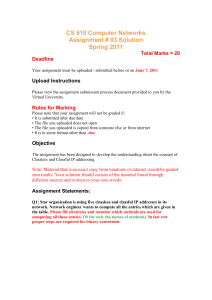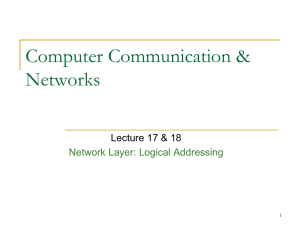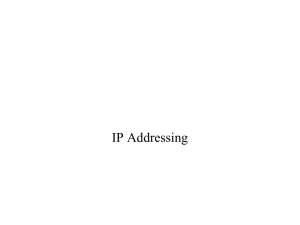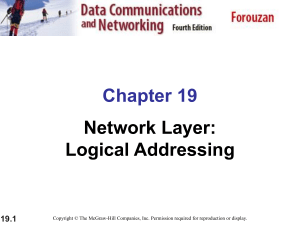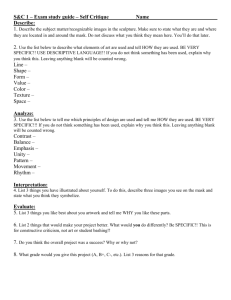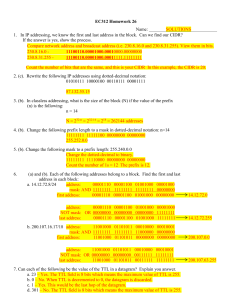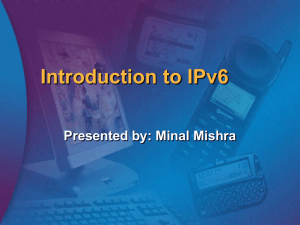Classful Addressing - NET 331 and net 221
advertisement
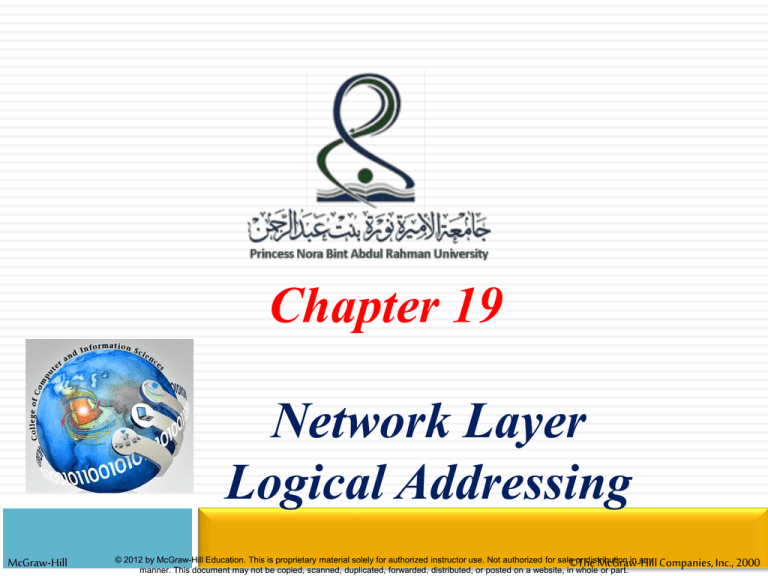
Chapter 19 Network Layer Logical Addressing McGraw-Hill ©The McGraw-Hill Companies, Inc., 2000 © 2012 by McGraw-Hill Education. This is proprietary material solely for authorized instructor use. Not authorized for sale or distribution in any manner. This document may not be copied, scanned, duplicated, forwarded, distributed, or posted on a website, in whole or part. 19-1 IPv4 ADDRESSES 19.2 An IPv4 address is a 32-bit address that uniquely and universally defines the connection of a device (for example, a computer or a router) to the Internet. Topics discussed: Address Space Notations Classful Addressing Classless Addressing Network Address Translation (NAT) IPv4 ADDRESSES 19.3 Two devices in the Internet can never have the same address at the same time. An address may be assigned to a device for a time period and then taken away and assigned to another device. If a device operating at the network layer (e.g. router) has m connections to the Internet, it needs to have m IP address. NOTE: The IPv4 addresses are unique and universal. IPv4 ADDRESSES 19.4 IPV4 has an address space: is the total number of addresses used by the protocol. If a protocol uses N bits to define an address, the address space is 2N . IPv4 uses 32-bit addresses: The address space=232 =4,294,967,296 ( more than 4 billion) This means, if there were no restrictions, more than 4 billion devices could be connected to the Internet. IPv6 uses 128 bit-addresses 19.1 IPv4 Addresses: Notations 19.5 There are two prevalent notations to show an IPv4 address: 1. Binary notation: Address is displayed as 32 bits. Each octet is often referred to as byte. IPv4 address referred to as 32-bit address or 4-byte address Example: 01110101 10010101 00011101 00000010 19.1 IPv4 Addresses: Notations 19.6 2. Dotted-decimal notation: More compact and easier to read Written in decimal form with a decimal point( dot) separating the bytes. Example: 117.149.29.2 Each decimal value range from 0 to 255 Example: Dotted-decimal notation and binary notation for an IPv4 Address 19.7 Example 1 19.8 Change the following IPv4 addresses from binary notation to dotted-decimal notation. Solution We replace each group of 8 bits with its equivalent decimal number (see Appendix B) and add dots for separation. Example 2 19.9 Change the following IPv4 addresses from dotted decimal notation to binary notation. Solution We replace each decimal number with its binary equivalent Example 3 19.10 Find the error, if any, in the following IPv4 addresses. Solution a. There must be no leading zero (045). b. There can be no more than four numbers. c. Each number needs to be less than or equal to 255. d. A mixture of binary notation and dotted-decimal notation is not allowed. IPv4 Addresses: Classful Addressing 19.11 In classful addressing, the address space is divided into five classes: A, B, C, D, and E. We can find the class of an address in: Binary notation: the first few bits define the class Decimal-dotted notation: the first byte define the class NOTES 19.12 In classful addressing, the address space is divided into five classes: A, B, C, D, and E. Addresses in Classes A, B and C are uniast addresses A host needs to have at least one unicast address to be able to send packet (Source). Addresses in Class D are for multicast address: used only for destination Addresses in class E are reserved Example 4 19.13 Find the class of each address. a. 00000001 00001011 00001011 11101111 b. 11000001 10000011 00011011 11111111 c. 14.23.120.8 d. 252.5.15.111 Solution a. The first bit is 0. This is a class A address. b. The first 2 bits are 1; the third bit is 0. This is a class C address. c. The first byte is 14; the class is A. d. The first byte is 252; the class is E. 19.1 : Classful Addressing: Classes and Blocks 19.14 NetId and HostId The address is divided into Netid and Hostid. These part are of varying lengths, depending on the class. Dose not apply to classes D and E 19.1 : Classful Addressing: Classes and Blocks 19.15 19.1 : Classful Addressing: Classes and Blocks 19.16 Class A address: designed for large organizations with a large number of attached hosts or routers. (most of the addresses were wasted and not used) Class B address: designed for midsize organizations with ten of thousands of attached hosts or routers( too large for many organizations) Class C address: designed for small organizations with a small number of attached hosts or routers (too small for many organizations) Class D address: designed for multicasting. (waste of addresses) Class E address: reserved for future use (waste of addresses) 19.17 One problem is that each class is divided into fixed number of blocks with each block having a fixed size NOTE In classful addressing, a large part of the available addresses were wasted. Classful Addressing: Classes and Blocks 19.18 Mask (default mask) Help us to find the NetId and HostId Mask: 32-bit made of 1s followed by 0s. Dose not apply to classes D and E. CIDR(Classless Interdomain Routing): used to show the mask in the form /n (n=8,16,24) Classful Addressing: Network address 19.19 The network address is an address that define the network itself to the reset of the internet. The network address has the following properties: 1. All hostid bytes are 0’s 2. It is the first address in the block 3. It cannot be assigned to a host 4. Given the network address, we can find the class of the address Example 5 19.20 Find the network address for the following: 1. 132.6.17.85 2. 23.56.7.91 Solution 1. The class is B. The first 2 bytes defines the Netid. We can find the network address by replacing the hostid bytes (17.85) with 0s. Therefore, the network address is 132.6.0.0. 2. The class is A. Only the first byte defines the Netid. We can find the network address by replacing the hostid bytes (56.7.91) with 0s. Therefore, the network address is 23.0.0.0. Classful Addressing: Network address 19.21 Classful addressing : subnetting 19.22 NOTE IP addresses are designed with two levels of hierarchy A network with two levels of hierarchy 19.23 Classful Addressing: Subnetting 19.24 If an organization was granted a large block in classes A or B It could divide the addresses into several contiguous groups and assign each group to smaller networks ( subnets) It increases the number of 1s in the mask Number of 1s in a subnet mask is more than the number of 1s in the corresponding mask. To make a subnet mask , we change some of the leftmost 0s in mask to 1s The number of subnets is determine by the number of extra1s. If the number of extra 1 is n, the number of subnets is 2n. If the number of subnets is N, the number of extra 1s is log2N Classful Addressing: Subnet Mask 19.25 Example 6: Class B address mask : 255.255.0.0 or /16 11111111 11111111 00000000 000000000 16 For 4 subnets : (log 2 4 = 2; need 2-extra bits ) Subnet mask: 255.255. 192.0 or /18 11111111 11111111 11 000000 00000000 2 14 For 8 subnets: (log 2 8 = 3; need 3-extra bits ) subnet mask : 255.255.224.0 or /19 11111111 11111111 111 3 00000 00000000 12 19.26 Example 6: A router receives a packet with destination address 190.240.33.91. Show how it finds the network and the subnetwork address to route the packet. Assume the subnet mask is /19 The router follows steps: 1. The router looks at the first byte of the address to find the class. It is class B. 2. The mask for class B is (/16)The router ANDs this mask with the address to get the network address :190.240.0.0. 3. The router applies the subnet mask (/19) to the address, 190.240.33.91: 190.240.001 00001.91 The subnet address is 190.240.32.0. 4. The router looks in its routing table to find how to route the packet to this destination Classful Addressing: Classes and Blocks 19.27 Supernetting Huge demand for midsize blocks. Although class A and B addresses are almost depleted, class C addresses are still available( size of block= 256 address did not satisfy the needs). In supernetting, an organization can combine several class C blocks to create a larger range of addresses. Several networks are combined to create a supernetwork ( supernet). e.g. Organization needs 1000 address can be granted 4 contiguous class C blocks to create one supernetwork. Decreases the number of 1s in the mask. E.g. The mask changes from /24 to /22 for 4 class C block Classful Addressing: Classes and Blocks 19.28 Address Depletion Near depletion of the available address because of the fast growth of the Internet. Run out of classes A and B address. Classes C block is too small for most mid size organizations. Solution: Classless addressing 19.29 NOTE Classful addressing, which is almost obsolete, is replaced with classless addressing. Classless Addressing: Address Blocks 19.30 To overcome address depletion. No classes, but the address are still granted in blocks. The size of the block( the number of addresses) varies based on the nature and size of the entity. Household: 2 addresses Large organization: thousands of addresses. ISP: thousands or hundreds of thousands based on the number of customers it may serve. Classless Addressing: Address Blocks 19.31 Restriction The Internet Authorities impose three restrictions: 1. The address in a block must be contiguous, one after another. 2. The number of addresses in a block must be a power of 2 ( 1,2,4,8,…) 3. The first address must be evenly divisible by the number of addresses. Example 8 19.32 The Figure in the next slide shows a block of addresses, in both binary and dotted-decimal notation, granted to a small business that needs 16 addresses A block of 16 addresses granted to a small organization 19.33 We can see that the restrictions are applied to this block.: • The addresses are contiguous. • The number of addresses is a power of 2 (16 = 24) • the first address is divisible by 16. The first address, when converted to a decimal number( use base 256), is 3,440,387,360, which when divided by 16 results in 215,024,210. Classless Addressing: Mask Mask: /n •32- bit •can take any value from 0 to 32, for ex /24 •The n leftmost bits are 1s •32-n rightmost bits are 0s 19.34 In IPv4 addressing, a block of addresses can be defined as x.y.z.t /n in which x.y.z.t defines one of the addresses and the /n defines the mask. Example: 172.31.16.42/26 Classless Addressing: Mask The address and the /n notation define the whole block: • First address • Last address •Number of address 19.35 •NOTE The first address in the block ( network address) can be found by setting the Rightmost 32 − n bits to 0s. Example 9 19.36 A block of addresses is granted to a small organization. We know that one of the addresses is 205.16.37.39/28. What is the first address in the block? Solution The binary representation of the given address is 11001101 00010000 00100101 00100111 205.16.37. 0010 0111 If we set 32−28 rightmost bits to 0, we get 205.16.37. 0010 0000 or 205.16.37.32. This is actually the block shown in example 8 NOTES 19.37 -The first address in a block is normally not assigned to any device; it is used as the network address that represents the organization to the rest of the world. -The last address in the block can be found by setting the rightmost 32 − n bits to 1s. Example 10 19.38 Find the last address for the block in Example 19.6. Solution The address is 205.16.37. 0010 0111 If we set 32 − 28 = 4 rightmost bits to 1, we get 205.16.37. 0010 1111 or 205.16.37.47 This is actually the block shown in Example 8 19.39 NOTES The number of addresses in the block can be found by using the formula 232−n. Example 11 19.40 Find the number of addresses in Example 19.6. Solution The value of n is 28, which means that number of addresses is 2 32−28 or 16. Example 12 19.41 Another way to find the first address, the last address, and the number of addresses is to represent the mask as a 32-bit binary (or 8-digit hexadecimal) number. This is particularly useful when we are writing a program to find these pieces of information. In Example 19.5 the /28 can be represented as 11111111 11111111 11111111 11110000 (twenty-eight 1s and four 0s). Find a. The first address b. The last address c. The number of addresses. Example 12 (cont,) 19.42 Solution a. The first address can be found by ANDing the given addresses with the mask. ANDing here is done bit by bit. The result of ANDing 2 bits is 1 if both bits are 1s; the result is 0 otherwise. Example 12 (cont,) 19.43 Solution b. The last address can be found by ORing the given addresses with the complement of the mask. ORing here is done bit by bit. The result of ORing 2 bits is 0 If both bits are 0s; the result is 1 otherwise. The complement of a number is found by changing each1 to 0 and each 0 to 1. Example 12 (cont,) 19.44 Solution c. The number of addresses can be found by complementing the mask, interpreting it as a decimal number, and adding 1 to it. A network configuration for the block 205.16.37.32/28 19.45 Classless addressing Two levels of hierarchy: No subnetting 19.46 19.47 NOTES Each address in the block can be considered as a two-level hierarchical structure: the leftmost n bits (prefix) define the network; the rightmost 32 − n bits define the host (suffix). Three level of hierarchy : subnetting 19.48 The organization has its own mask : network mask Each subnet must also have its own mask: subnet mask Three-level hierarchy in an IPv4 address 19.49
